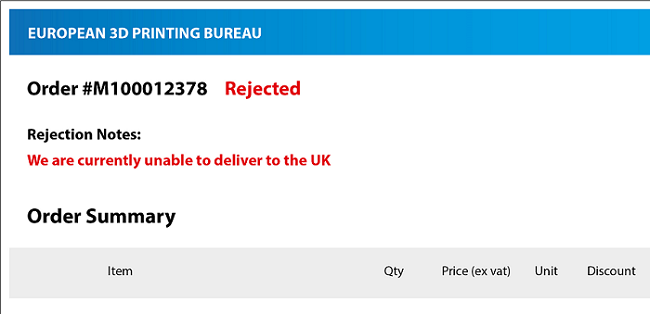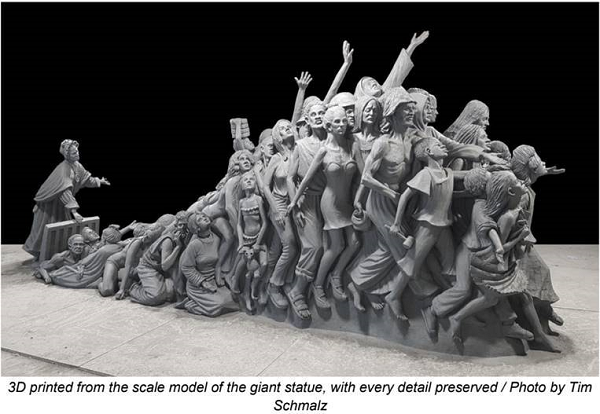3D Printing News Briefs, April 11, 2021: Qontrol & 3DPRINTUK, Carbon & NADL, Zortrax, Artec 3D & Objex Unlimited
We’ve got a little business news to share with you in today’s 3D Printing News Briefs, followed by news about a new material. Then, it’s on to two stories about 3D technology being used to turn stunning pieces of art into awesome 3D printed versions. Read on for the details!
3DPRINTUK Maintains Strong Supply Chain
As the official Brexit date approached last year, government agencies and officials urged businesses to get ready for the changes that would come once the UK withdrew from the European Union, and the start of the COVID-19 pandemic didn’t help the inevitable disruptions. Many forward-looking companies, such as low-volume industrial 3D printing specialist 3DPRINTUK, began reassessing their supply chains, so that international customers wouldn’t see a break in services amidst the chaos. In some cases, companies that used international service providers had their orders refused; this is what happened to new 3DPRINTUK client Qontrol Ltd., which uses 3D printing to make instruments for use in quantum science R&D. One of the ways that 3DPRINTUK has continued service without supply chain interruptions is its use of UPS Express, as opposed to road freight, until the world settles down again. This allows its clients to receive their orders without delay.
“We have been long-time regular customers of a continental-European print service. Very simply, we needed to place an urgent order with them just before Christmas 2020, and they refused it down to uncertainty around Brexit,” explained Qontrol Ltd.’s CTO Dr Josh Silverstone. “Looking for alternatives, we stumbled on 3DPRINTUK, and we couldn’t be happier. 3DPRINTUK’s parts are at least as high-quality as our old supplier, with very competitive pricing and generally faster turn-around, without the new Brexit customs headaches. We’ve decided to use them as our main 3D printer, going forward, and we hope they keep up the good work!”
NADL Names Carbon 2021 Supplier Member of the Year
The National Association of Dental Laboratories (NADL) annually recognizes companies and individuals who have significantly contributed to the dental laboratory profession, and this year named Carbon its 2021 Supplier Member of the Year, due to its continued 3D printing innovations in the dental industry and the fact that these solutions offer accuracy, reliability, and throughput for a higher return on investment. In last year’s NADL 3D printer survey, the company was named #1 in customer satisfaction for the second year running, and was the most preferred brand by dental labs. A Carbon subscription includes all scheduled maintenance, in addition to service notifications, over-the-air software updates, and remote monitoring and trouble-shooting for a more proactive customer service offering. In addition, the company is continuing to advance its platform to meet the needs of dental laboratories, offering exclusive access to resins and workflows to print premium Lucitone Digital Print Dentures and Keysplint Soft Clear night guards.
“Our dental lab customers avoid the historical approach of making large investments to purchase equipment that is obsolete within a few short years. We reimagined and solved this frustration with a subscription model so that our printers improve over time,” said Todd Ames, Vice President, Oral Health, at Carbon.
“We are honored to be recognized by the National Association of Dental Laboratories for our continued innovation and contributions to dental labs. The evolution of our platform is a direct result of us listening to our customers and developing features that help them bring products to market in less time.”
Zortrax Introduces New Filament, Print Profiles for Endureal
Polish 3D printing solutions provider Zortrax has announced a new high-performance filament, polyetherimide blend Z-PEI 1010, that’s compatible with its industrial Zortrax Endureal 3D printer. This high-performance polymer has very high heat deflection temperature, mechanical strength, and rigidity, as well as being resistant to many chemicals. All of these properties combined make it a good choice for things like load-bearing parts, piping components, electronics housings, and industrial assembly jigs. Additionally, the company is adding an option to work with external materials based on ABS, PEI 9085, and PEI 1010; these new print profiles means that the Endureal is now an even better system for applications in the automotive, aviation, space, and chemical industries.
“Introducing Z-PEI 1010 is the next logical step in a wider process of pushing the Endureal’s capabilities even further in advanced 3D printing applications such as space, aviation, or heavy industry. But offering fine-tuned printing profiles for dedicated filaments is one thing, and leaving engineers and other professional users with freedom to choose the right materials for their specific applications is quite another,” stated Marta Shalima, the Business Development Director at Zortrax S.A. “To achieve that, we are also opening the Endureal to external high-performance polymers based on most commonly used blends of PEI.”
3D Scanning & Printing Used to Scale Down Sculpture
Canadian sculptor Timothy Schmalz used 3D technology to convert his own 20-foot clay sculpture into a scale model, in order to create ten true-to-size cast bronze statues, as well as many smaller 3D printed versions that are being sent to hundreds of international locations…one will even be presented to the Pope! The Vatican actually commissioned the original sculpture, called “Let the Oppressed Go Free,” to raise awareness about human trafficking—about 100 figures are represented in the statue, including a child bride and a child soldier, young victims of sex and organ trafficking, sex slaves, and more. Schmalz worked with Gold Certified Artec 3D partner Objex Unlimited to scan the statue in three hours over two days using the Artec Leo and its HD Mode. Two hours were then needed to upload all the data, and then ten hours to piece it all together and clean it up with Artec Studio software and ZBrush. The 65-70 cm versions of the statue are being 3D printed on Mimaki printers, and this smaller one makes the artwork so much more accessible to people.
“It’s very powerful to turn the large statue into a smaller size so that more people can see it. The detail in this printed statue is unbelievable. But not only the detail, even the human expression to be seen within this small scan. It’s just absolutely unbelievable,” Schmalz said in an Artec case study.
“[As an artist] I am completely thankful for this ‘little’ scan that has brought a 20-ft sculpture – which is very hard to move – to a smaller scale.
“Pope Francis said that human trafficking will always exist, if it’s kept underground. And this sculpture, and the small replica, brings awareness and it brings it out from under the ground.”
Monet’s Masterpiece Turned into 3D Printed Object
Victoria University of Wellington masters’ student Joseph Coddington used voxel 3D printing to help audiences better understand and reconnect with the stunning “Water Lilies” series of oil paintings completed by French Impressionist artist Claude Monet during the last 30 years of his life at home in Giverny. The series is his masterpiece, due to the panoramic display, use of color, and deep understanding of light and depth, and the fact that he painted most of the works while he was suffering from cataracts. To turn the flat paintings into true three-dimensional objects, Coddington built up 15 layers of images in Adobe Photoshop, each of which had color applied based on observations of the original.
“Voxel printing can expose the 2D plane, and offer fragments of material to be dispersed through the crafted object,” Coddington explained. “When a backlight shines through the print we get a similar quality to light rays shining through a pond, as the light illuminates and is distorted by the material fragments. The voxel print has a type of cinematography quality to it, due to harness light within an object, which separates the print from most Stratasys J750 prints. The ability to harness light showcases the depth and 3D nature of crafted objects in ways Monet is unable to capture.”
Coddington used the Stratasys J750 printer to fabricate a small, handheld print, which reminds me a little of the Full-Color Voxel Woman, also printed on the J750 by a Victoria University of Wellington student.
Subscribe to Our Email Newsletter
Stay up-to-date on all the latest news from the 3D printing industry and receive information and offers from third party vendors.
You May Also Like
Further Understanding of 3D Printing Design at ADDITIV Design World
ADDITIV is back once again! This time, the virtual platform for additive manufacturing will be holding the first-ever edition of ADDITIV Design World on May 23rd from 9:00 AM –...
3D Printer Maker EVO-tech Reborn as NEVO3D — Once More With Feeling
EVO-tech was a 3D printing service and original equipment manufacturer established in 2013 and based in Schörfling am Attersee, Austria. The company produced high-quality material extrusion systems featuring linear bearings,...
3D Systems Brings 3D Printed PEEK Cranial Implant to the U.S. with FDA Clearance
For more than 10 years, 3D Systems (NYSE:DDD) has worked hand-in-hand with surgeons to plan over 150,000 patient-specific cases, and develop more than two million instruments and implants from its...
CDFAM Returns to Berlin for Second Annual Symposium
The second CDFAM Computational Design Symposium is scheduled for May 7-8, 2024, in Berlin, and will convene leading experts in computational design across all scales. Building upon the first event...




































